Analyzing CRM Implementation for Profit: A DBA Case Study
VerifiedAdded on 2020/12/09
|43
|12752
|340
Report
AI Summary
This report examines the potential of Customer Relationship Management (CRM) systems to enhance working processes and increase profits within UK trade bodies, using the Design Business Association (DBA) as a case study. The research investigates the importance of CRM, its role in building customer relationships, and its impact on business processes and profitability. The report employs a mixed-methods approach, including a literature review, primary data collection through questionnaires, and data analysis to identify the benefits and challenges of CRM implementation. The findings highlight CRM's effectiveness in time management, customer understanding, and improving customer relationships, ultimately leading to increased sales and profitability. The study concludes with recommendations for DBA and other trade bodies on effectively utilizing CRM systems to optimize their operations and achieve their business objectives.
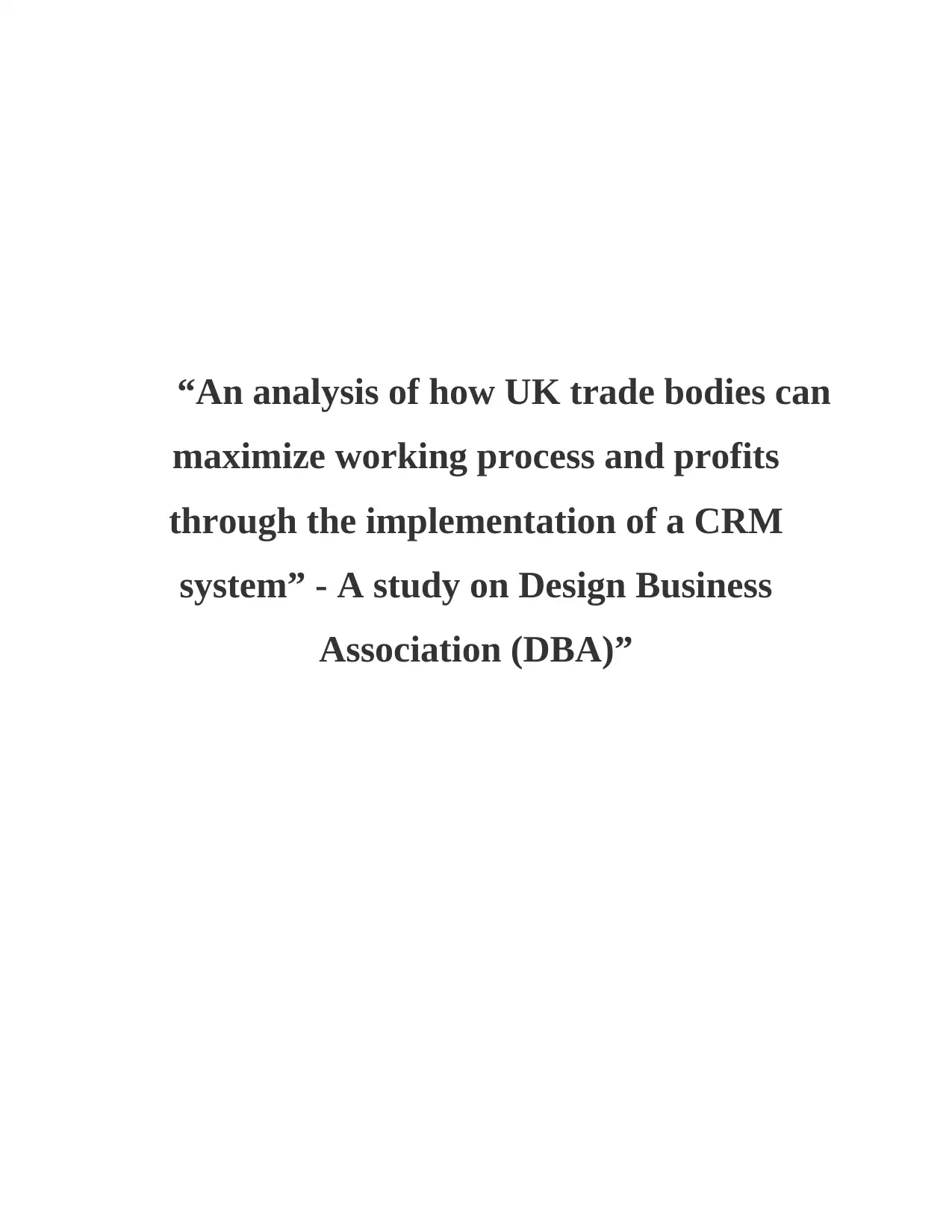
“An analysis of how UK trade bodies can
maximize working process and profits
through the implementation of a CRM
system” - A study on Design Business
Association (DBA)”
maximize working process and profits
through the implementation of a CRM
system” - A study on Design Business
Association (DBA)”
Paraphrase This Document
Need a fresh take? Get an instant paraphrase of this document with our AI Paraphraser
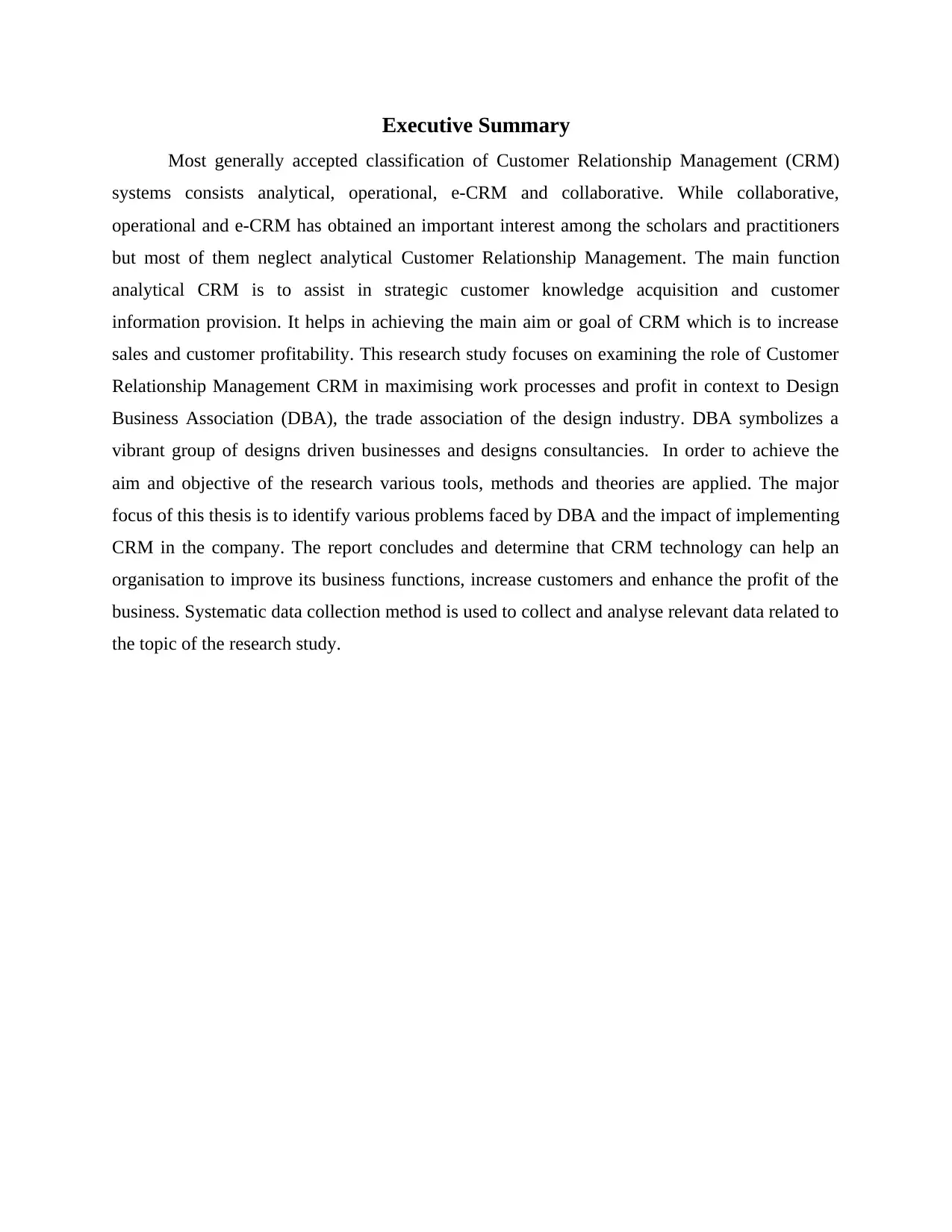
Executive Summary
Most generally accepted classification of Customer Relationship Management (CRM)
systems consists analytical, operational, e-CRM and collaborative. While collaborative,
operational and e-CRM has obtained an important interest among the scholars and practitioners
but most of them neglect analytical Customer Relationship Management. The main function
analytical CRM is to assist in strategic customer knowledge acquisition and customer
information provision. It helps in achieving the main aim or goal of CRM which is to increase
sales and customer profitability. This research study focuses on examining the role of Customer
Relationship Management CRM in maximising work processes and profit in context to Design
Business Association (DBA), the trade association of the design industry. DBA symbolizes a
vibrant group of designs driven businesses and designs consultancies. In order to achieve the
aim and objective of the research various tools, methods and theories are applied. The major
focus of this thesis is to identify various problems faced by DBA and the impact of implementing
CRM in the company. The report concludes and determine that CRM technology can help an
organisation to improve its business functions, increase customers and enhance the profit of the
business. Systematic data collection method is used to collect and analyse relevant data related to
the topic of the research study.
Most generally accepted classification of Customer Relationship Management (CRM)
systems consists analytical, operational, e-CRM and collaborative. While collaborative,
operational and e-CRM has obtained an important interest among the scholars and practitioners
but most of them neglect analytical Customer Relationship Management. The main function
analytical CRM is to assist in strategic customer knowledge acquisition and customer
information provision. It helps in achieving the main aim or goal of CRM which is to increase
sales and customer profitability. This research study focuses on examining the role of Customer
Relationship Management CRM in maximising work processes and profit in context to Design
Business Association (DBA), the trade association of the design industry. DBA symbolizes a
vibrant group of designs driven businesses and designs consultancies. In order to achieve the
aim and objective of the research various tools, methods and theories are applied. The major
focus of this thesis is to identify various problems faced by DBA and the impact of implementing
CRM in the company. The report concludes and determine that CRM technology can help an
organisation to improve its business functions, increase customers and enhance the profit of the
business. Systematic data collection method is used to collect and analyse relevant data related to
the topic of the research study.
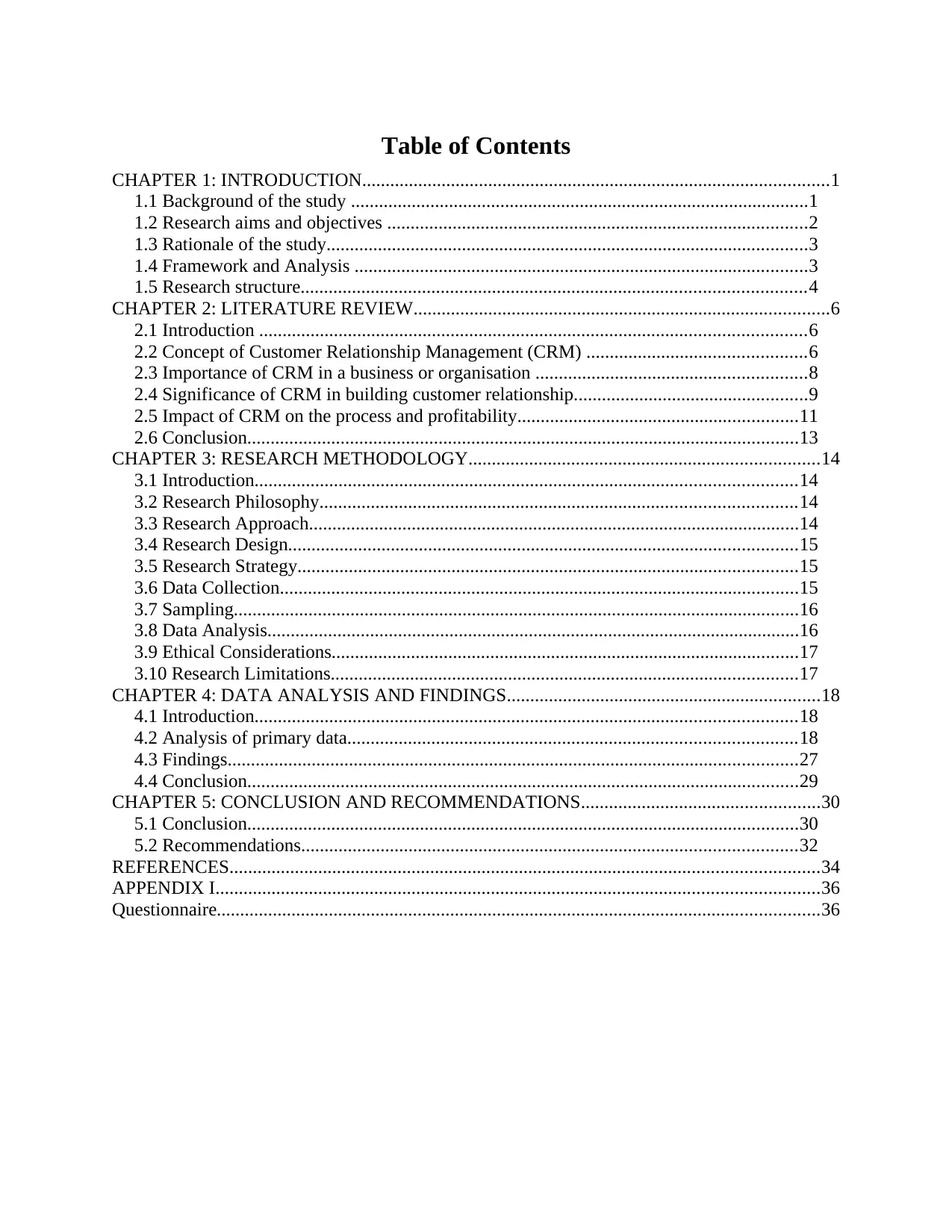
Table of Contents
CHAPTER 1: INTRODUCTION....................................................................................................1
1.1 Background of the study ..................................................................................................1
1.2 Research aims and objectives ..........................................................................................2
1.3 Rationale of the study.......................................................................................................3
1.4 Framework and Analysis .................................................................................................3
1.5 Research structure............................................................................................................4
CHAPTER 2: LITERATURE REVIEW.........................................................................................6
2.1 Introduction .....................................................................................................................6
2.2 Concept of Customer Relationship Management (CRM) ...............................................6
2.3 Importance of CRM in a business or organisation ..........................................................8
2.4 Significance of CRM in building customer relationship..................................................9
2.5 Impact of CRM on the process and profitability............................................................11
2.6 Conclusion......................................................................................................................13
CHAPTER 3: RESEARCH METHODOLOGY...........................................................................14
3.1 Introduction....................................................................................................................14
3.2 Research Philosophy......................................................................................................14
3.3 Research Approach.........................................................................................................14
3.4 Research Design.............................................................................................................15
3.5 Research Strategy...........................................................................................................15
3.6 Data Collection...............................................................................................................15
3.7 Sampling.........................................................................................................................16
3.8 Data Analysis..................................................................................................................16
3.9 Ethical Considerations....................................................................................................17
3.10 Research Limitations....................................................................................................17
CHAPTER 4: DATA ANALYSIS AND FINDINGS...................................................................18
4.1 Introduction....................................................................................................................18
4.2 Analysis of primary data................................................................................................18
4.3 Findings..........................................................................................................................27
4.4 Conclusion......................................................................................................................29
CHAPTER 5: CONCLUSION AND RECOMMENDATIONS...................................................30
5.1 Conclusion......................................................................................................................30
5.2 Recommendations..........................................................................................................32
REFERENCES..............................................................................................................................34
APPENDIX I.................................................................................................................................36
Questionnaire.................................................................................................................................36
CHAPTER 1: INTRODUCTION....................................................................................................1
1.1 Background of the study ..................................................................................................1
1.2 Research aims and objectives ..........................................................................................2
1.3 Rationale of the study.......................................................................................................3
1.4 Framework and Analysis .................................................................................................3
1.5 Research structure............................................................................................................4
CHAPTER 2: LITERATURE REVIEW.........................................................................................6
2.1 Introduction .....................................................................................................................6
2.2 Concept of Customer Relationship Management (CRM) ...............................................6
2.3 Importance of CRM in a business or organisation ..........................................................8
2.4 Significance of CRM in building customer relationship..................................................9
2.5 Impact of CRM on the process and profitability............................................................11
2.6 Conclusion......................................................................................................................13
CHAPTER 3: RESEARCH METHODOLOGY...........................................................................14
3.1 Introduction....................................................................................................................14
3.2 Research Philosophy......................................................................................................14
3.3 Research Approach.........................................................................................................14
3.4 Research Design.............................................................................................................15
3.5 Research Strategy...........................................................................................................15
3.6 Data Collection...............................................................................................................15
3.7 Sampling.........................................................................................................................16
3.8 Data Analysis..................................................................................................................16
3.9 Ethical Considerations....................................................................................................17
3.10 Research Limitations....................................................................................................17
CHAPTER 4: DATA ANALYSIS AND FINDINGS...................................................................18
4.1 Introduction....................................................................................................................18
4.2 Analysis of primary data................................................................................................18
4.3 Findings..........................................................................................................................27
4.4 Conclusion......................................................................................................................29
CHAPTER 5: CONCLUSION AND RECOMMENDATIONS...................................................30
5.1 Conclusion......................................................................................................................30
5.2 Recommendations..........................................................................................................32
REFERENCES..............................................................................................................................34
APPENDIX I.................................................................................................................................36
Questionnaire.................................................................................................................................36
⊘ This is a preview!⊘
Do you want full access?
Subscribe today to unlock all pages.

Trusted by 1+ million students worldwide
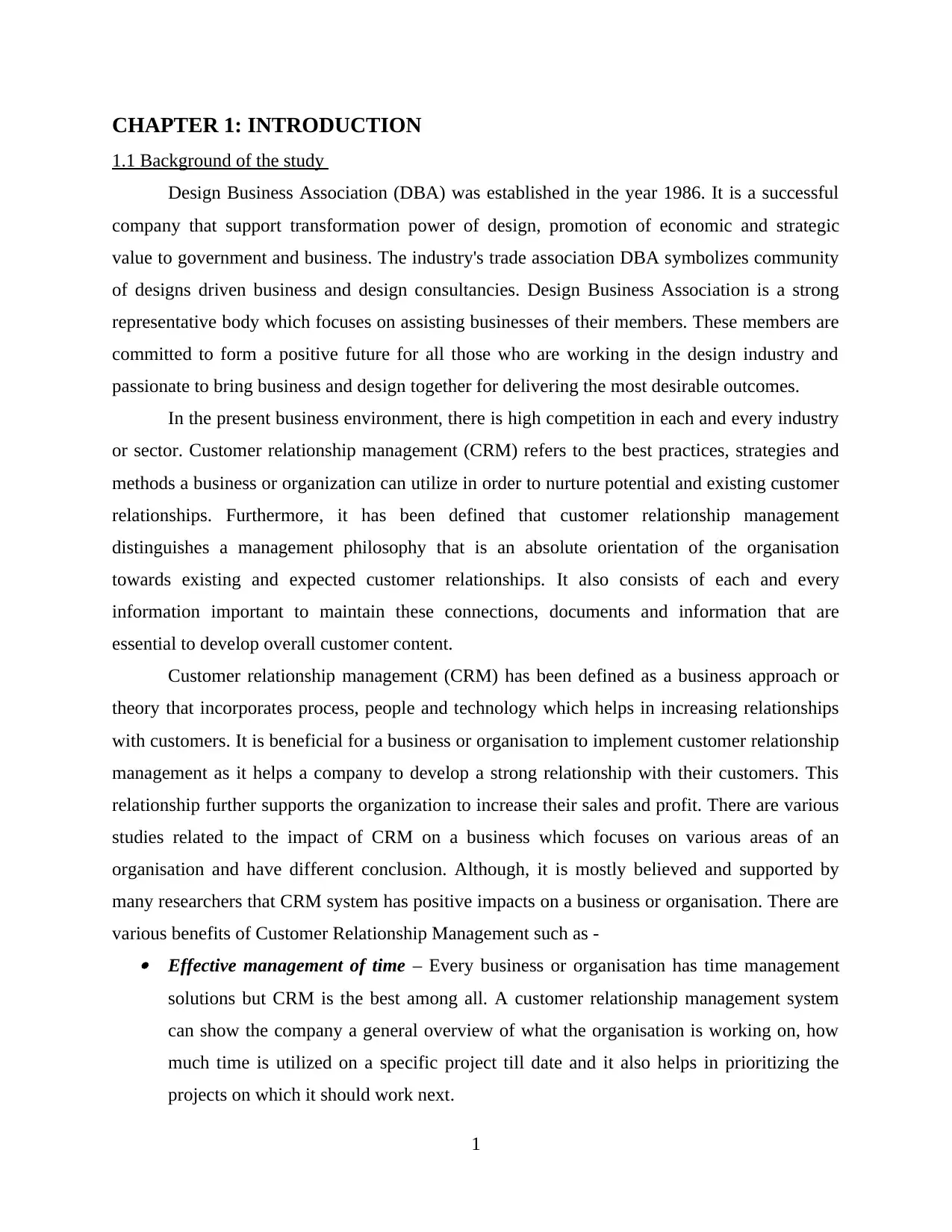
CHAPTER 1: INTRODUCTION
1.1 Background of the study
Design Business Association (DBA) was established in the year 1986. It is a successful
company that support transformation power of design, promotion of economic and strategic
value to government and business. The industry's trade association DBA symbolizes community
of designs driven business and design consultancies. Design Business Association is a strong
representative body which focuses on assisting businesses of their members. These members are
committed to form a positive future for all those who are working in the design industry and
passionate to bring business and design together for delivering the most desirable outcomes.
In the present business environment, there is high competition in each and every industry
or sector. Customer relationship management (CRM) refers to the best practices, strategies and
methods a business or organization can utilize in order to nurture potential and existing customer
relationships. Furthermore, it has been defined that customer relationship management
distinguishes a management philosophy that is an absolute orientation of the organisation
towards existing and expected customer relationships. It also consists of each and every
information important to maintain these connections, documents and information that are
essential to develop overall customer content.
Customer relationship management (CRM) has been defined as a business approach or
theory that incorporates process, people and technology which helps in increasing relationships
with customers. It is beneficial for a business or organisation to implement customer relationship
management as it helps a company to develop a strong relationship with their customers. This
relationship further supports the organization to increase their sales and profit. There are various
studies related to the impact of CRM on a business which focuses on various areas of an
organisation and have different conclusion. Although, it is mostly believed and supported by
many researchers that CRM system has positive impacts on a business or organisation. There are
various benefits of Customer Relationship Management such as - Effective management of time – Every business or organisation has time management
solutions but CRM is the best among all. A customer relationship management system
can show the company a general overview of what the organisation is working on, how
much time is utilized on a specific project till date and it also helps in prioritizing the
projects on which it should work next.
1
1.1 Background of the study
Design Business Association (DBA) was established in the year 1986. It is a successful
company that support transformation power of design, promotion of economic and strategic
value to government and business. The industry's trade association DBA symbolizes community
of designs driven business and design consultancies. Design Business Association is a strong
representative body which focuses on assisting businesses of their members. These members are
committed to form a positive future for all those who are working in the design industry and
passionate to bring business and design together for delivering the most desirable outcomes.
In the present business environment, there is high competition in each and every industry
or sector. Customer relationship management (CRM) refers to the best practices, strategies and
methods a business or organization can utilize in order to nurture potential and existing customer
relationships. Furthermore, it has been defined that customer relationship management
distinguishes a management philosophy that is an absolute orientation of the organisation
towards existing and expected customer relationships. It also consists of each and every
information important to maintain these connections, documents and information that are
essential to develop overall customer content.
Customer relationship management (CRM) has been defined as a business approach or
theory that incorporates process, people and technology which helps in increasing relationships
with customers. It is beneficial for a business or organisation to implement customer relationship
management as it helps a company to develop a strong relationship with their customers. This
relationship further supports the organization to increase their sales and profit. There are various
studies related to the impact of CRM on a business which focuses on various areas of an
organisation and have different conclusion. Although, it is mostly believed and supported by
many researchers that CRM system has positive impacts on a business or organisation. There are
various benefits of Customer Relationship Management such as - Effective management of time – Every business or organisation has time management
solutions but CRM is the best among all. A customer relationship management system
can show the company a general overview of what the organisation is working on, how
much time is utilized on a specific project till date and it also helps in prioritizing the
projects on which it should work next.
1
Paraphrase This Document
Need a fresh take? Get an instant paraphrase of this document with our AI Paraphraser
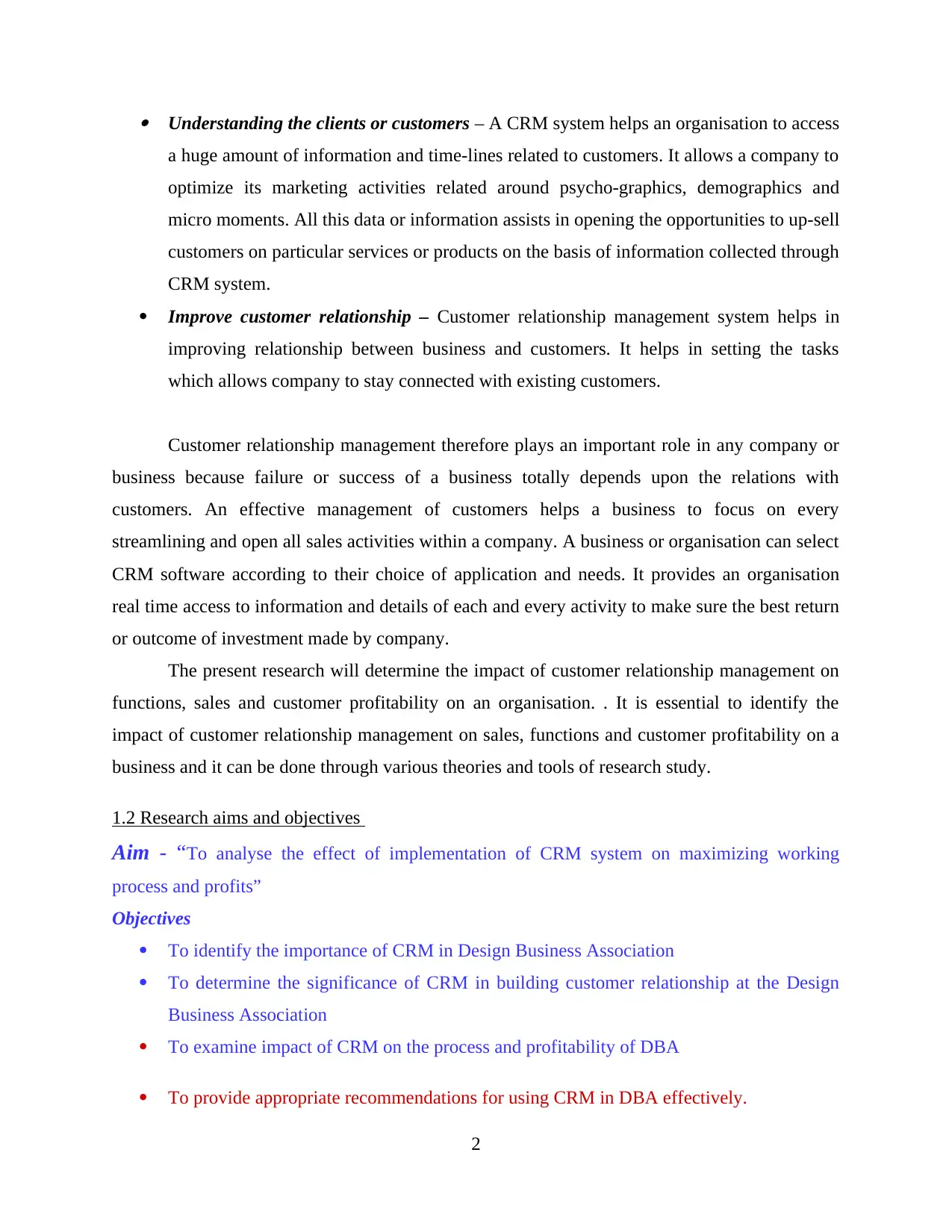
Understanding the clients or customers – A CRM system helps an organisation to access
a huge amount of information and time-lines related to customers. It allows a company to
optimize its marketing activities related around psycho-graphics, demographics and
micro moments. All this data or information assists in opening the opportunities to up-sell
customers on particular services or products on the basis of information collected through
CRM system.
Improve customer relationship – Customer relationship management system helps in
improving relationship between business and customers. It helps in setting the tasks
which allows company to stay connected with existing customers.
Customer relationship management therefore plays an important role in any company or
business because failure or success of a business totally depends upon the relations with
customers. An effective management of customers helps a business to focus on every
streamlining and open all sales activities within a company. A business or organisation can select
CRM software according to their choice of application and needs. It provides an organisation
real time access to information and details of each and every activity to make sure the best return
or outcome of investment made by company.
The present research will determine the impact of customer relationship management on
functions, sales and customer profitability on an organisation. . It is essential to identify the
impact of customer relationship management on sales, functions and customer profitability on a
business and it can be done through various theories and tools of research study.
1.2 Research aims and objectives
Aim - “To analyse the effect of implementation of CRM system on maximizing working
process and profits”
Objectives
To identify the importance of CRM in Design Business Association
To determine the significance of CRM in building customer relationship at the Design
Business Association
To examine impact of CRM on the process and profitability of DBA
To provide appropriate recommendations for using CRM in DBA effectively.
2
a huge amount of information and time-lines related to customers. It allows a company to
optimize its marketing activities related around psycho-graphics, demographics and
micro moments. All this data or information assists in opening the opportunities to up-sell
customers on particular services or products on the basis of information collected through
CRM system.
Improve customer relationship – Customer relationship management system helps in
improving relationship between business and customers. It helps in setting the tasks
which allows company to stay connected with existing customers.
Customer relationship management therefore plays an important role in any company or
business because failure or success of a business totally depends upon the relations with
customers. An effective management of customers helps a business to focus on every
streamlining and open all sales activities within a company. A business or organisation can select
CRM software according to their choice of application and needs. It provides an organisation
real time access to information and details of each and every activity to make sure the best return
or outcome of investment made by company.
The present research will determine the impact of customer relationship management on
functions, sales and customer profitability on an organisation. . It is essential to identify the
impact of customer relationship management on sales, functions and customer profitability on a
business and it can be done through various theories and tools of research study.
1.2 Research aims and objectives
Aim - “To analyse the effect of implementation of CRM system on maximizing working
process and profits”
Objectives
To identify the importance of CRM in Design Business Association
To determine the significance of CRM in building customer relationship at the Design
Business Association
To examine impact of CRM on the process and profitability of DBA
To provide appropriate recommendations for using CRM in DBA effectively.
2
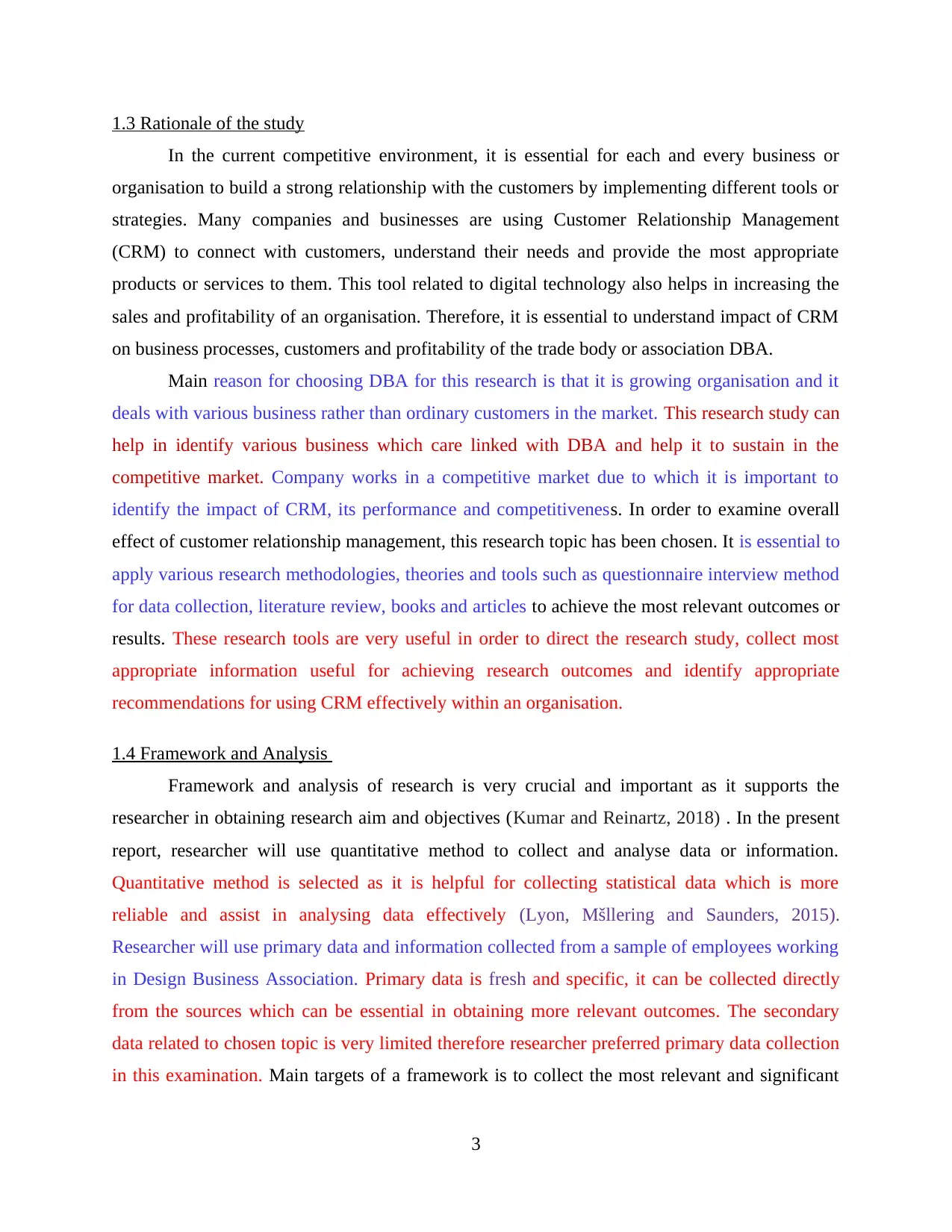
1.3 Rationale of the study
In the current competitive environment, it is essential for each and every business or
organisation to build a strong relationship with the customers by implementing different tools or
strategies. Many companies and businesses are using Customer Relationship Management
(CRM) to connect with customers, understand their needs and provide the most appropriate
products or services to them. This tool related to digital technology also helps in increasing the
sales and profitability of an organisation. Therefore, it is essential to understand impact of CRM
on business processes, customers and profitability of the trade body or association DBA.
Main reason for choosing DBA for this research is that it is growing organisation and it
deals with various business rather than ordinary customers in the market. This research study can
help in identify various business which care linked with DBA and help it to sustain in the
competitive market. Company works in a competitive market due to which it is important to
identify the impact of CRM, its performance and competitiveness. In order to examine overall
effect of customer relationship management, this research topic has been chosen. It is essential to
apply various research methodologies, theories and tools such as questionnaire interview method
for data collection, literature review, books and articles to achieve the most relevant outcomes or
results. These research tools are very useful in order to direct the research study, collect most
appropriate information useful for achieving research outcomes and identify appropriate
recommendations for using CRM effectively within an organisation.
1.4 Framework and Analysis
Framework and analysis of research is very crucial and important as it supports the
researcher in obtaining research aim and objectives (Kumar and Reinartz, 2018) . In the present
report, researcher will use quantitative method to collect and analyse data or information.
Quantitative method is selected as it is helpful for collecting statistical data which is more
reliable and assist in analysing data effectively (Lyon, Mšllering and Saunders, 2015).
Researcher will use primary data and information collected from a sample of employees working
in Design Business Association. Primary data is fresh and specific, it can be collected directly
from the sources which can be essential in obtaining more relevant outcomes. The secondary
data related to chosen topic is very limited therefore researcher preferred primary data collection
in this examination. Main targets of a framework is to collect the most relevant and significant
3
In the current competitive environment, it is essential for each and every business or
organisation to build a strong relationship with the customers by implementing different tools or
strategies. Many companies and businesses are using Customer Relationship Management
(CRM) to connect with customers, understand their needs and provide the most appropriate
products or services to them. This tool related to digital technology also helps in increasing the
sales and profitability of an organisation. Therefore, it is essential to understand impact of CRM
on business processes, customers and profitability of the trade body or association DBA.
Main reason for choosing DBA for this research is that it is growing organisation and it
deals with various business rather than ordinary customers in the market. This research study can
help in identify various business which care linked with DBA and help it to sustain in the
competitive market. Company works in a competitive market due to which it is important to
identify the impact of CRM, its performance and competitiveness. In order to examine overall
effect of customer relationship management, this research topic has been chosen. It is essential to
apply various research methodologies, theories and tools such as questionnaire interview method
for data collection, literature review, books and articles to achieve the most relevant outcomes or
results. These research tools are very useful in order to direct the research study, collect most
appropriate information useful for achieving research outcomes and identify appropriate
recommendations for using CRM effectively within an organisation.
1.4 Framework and Analysis
Framework and analysis of research is very crucial and important as it supports the
researcher in obtaining research aim and objectives (Kumar and Reinartz, 2018) . In the present
report, researcher will use quantitative method to collect and analyse data or information.
Quantitative method is selected as it is helpful for collecting statistical data which is more
reliable and assist in analysing data effectively (Lyon, Mšllering and Saunders, 2015).
Researcher will use primary data and information collected from a sample of employees working
in Design Business Association. Primary data is fresh and specific, it can be collected directly
from the sources which can be essential in obtaining more relevant outcomes. The secondary
data related to chosen topic is very limited therefore researcher preferred primary data collection
in this examination. Main targets of a framework is to collect the most relevant and significant
3
⊘ This is a preview!⊘
Do you want full access?
Subscribe today to unlock all pages.

Trusted by 1+ million students worldwide
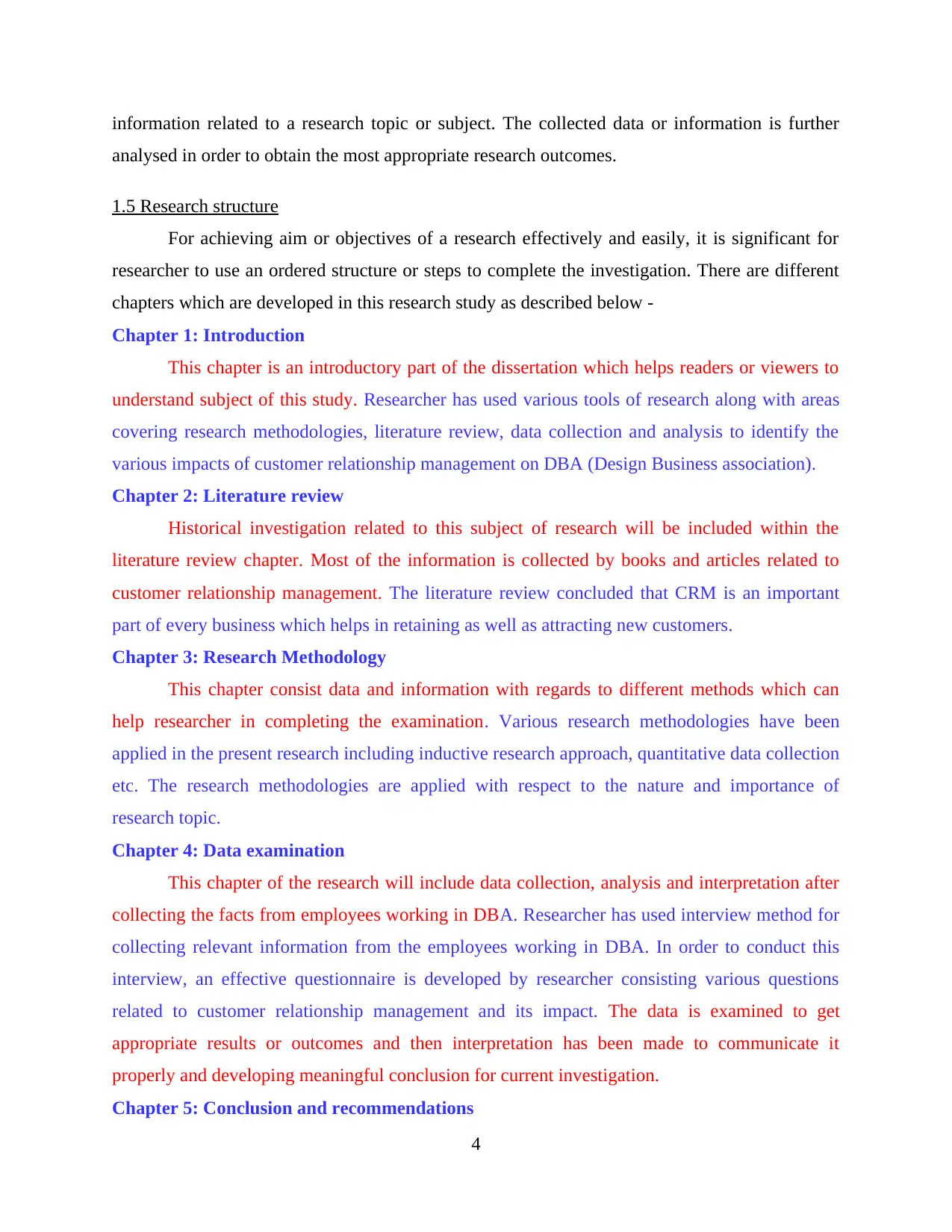
information related to a research topic or subject. The collected data or information is further
analysed in order to obtain the most appropriate research outcomes.
1.5 Research structure
For achieving aim or objectives of a research effectively and easily, it is significant for
researcher to use an ordered structure or steps to complete the investigation. There are different
chapters which are developed in this research study as described below -
Chapter 1: Introduction
This chapter is an introductory part of the dissertation which helps readers or viewers to
understand subject of this study. Researcher has used various tools of research along with areas
covering research methodologies, literature review, data collection and analysis to identify the
various impacts of customer relationship management on DBA (Design Business association).
Chapter 2: Literature review
Historical investigation related to this subject of research will be included within the
literature review chapter. Most of the information is collected by books and articles related to
customer relationship management. The literature review concluded that CRM is an important
part of every business which helps in retaining as well as attracting new customers.
Chapter 3: Research Methodology
This chapter consist data and information with regards to different methods which can
help researcher in completing the examination. Various research methodologies have been
applied in the present research including inductive research approach, quantitative data collection
etc. The research methodologies are applied with respect to the nature and importance of
research topic.
Chapter 4: Data examination
This chapter of the research will include data collection, analysis and interpretation after
collecting the facts from employees working in DBA. Researcher has used interview method for
collecting relevant information from the employees working in DBA. In order to conduct this
interview, an effective questionnaire is developed by researcher consisting various questions
related to customer relationship management and its impact. The data is examined to get
appropriate results or outcomes and then interpretation has been made to communicate it
properly and developing meaningful conclusion for current investigation.
Chapter 5: Conclusion and recommendations
4
analysed in order to obtain the most appropriate research outcomes.
1.5 Research structure
For achieving aim or objectives of a research effectively and easily, it is significant for
researcher to use an ordered structure or steps to complete the investigation. There are different
chapters which are developed in this research study as described below -
Chapter 1: Introduction
This chapter is an introductory part of the dissertation which helps readers or viewers to
understand subject of this study. Researcher has used various tools of research along with areas
covering research methodologies, literature review, data collection and analysis to identify the
various impacts of customer relationship management on DBA (Design Business association).
Chapter 2: Literature review
Historical investigation related to this subject of research will be included within the
literature review chapter. Most of the information is collected by books and articles related to
customer relationship management. The literature review concluded that CRM is an important
part of every business which helps in retaining as well as attracting new customers.
Chapter 3: Research Methodology
This chapter consist data and information with regards to different methods which can
help researcher in completing the examination. Various research methodologies have been
applied in the present research including inductive research approach, quantitative data collection
etc. The research methodologies are applied with respect to the nature and importance of
research topic.
Chapter 4: Data examination
This chapter of the research will include data collection, analysis and interpretation after
collecting the facts from employees working in DBA. Researcher has used interview method for
collecting relevant information from the employees working in DBA. In order to conduct this
interview, an effective questionnaire is developed by researcher consisting various questions
related to customer relationship management and its impact. The data is examined to get
appropriate results or outcomes and then interpretation has been made to communicate it
properly and developing meaningful conclusion for current investigation.
Chapter 5: Conclusion and recommendations
4
Paraphrase This Document
Need a fresh take? Get an instant paraphrase of this document with our AI Paraphraser
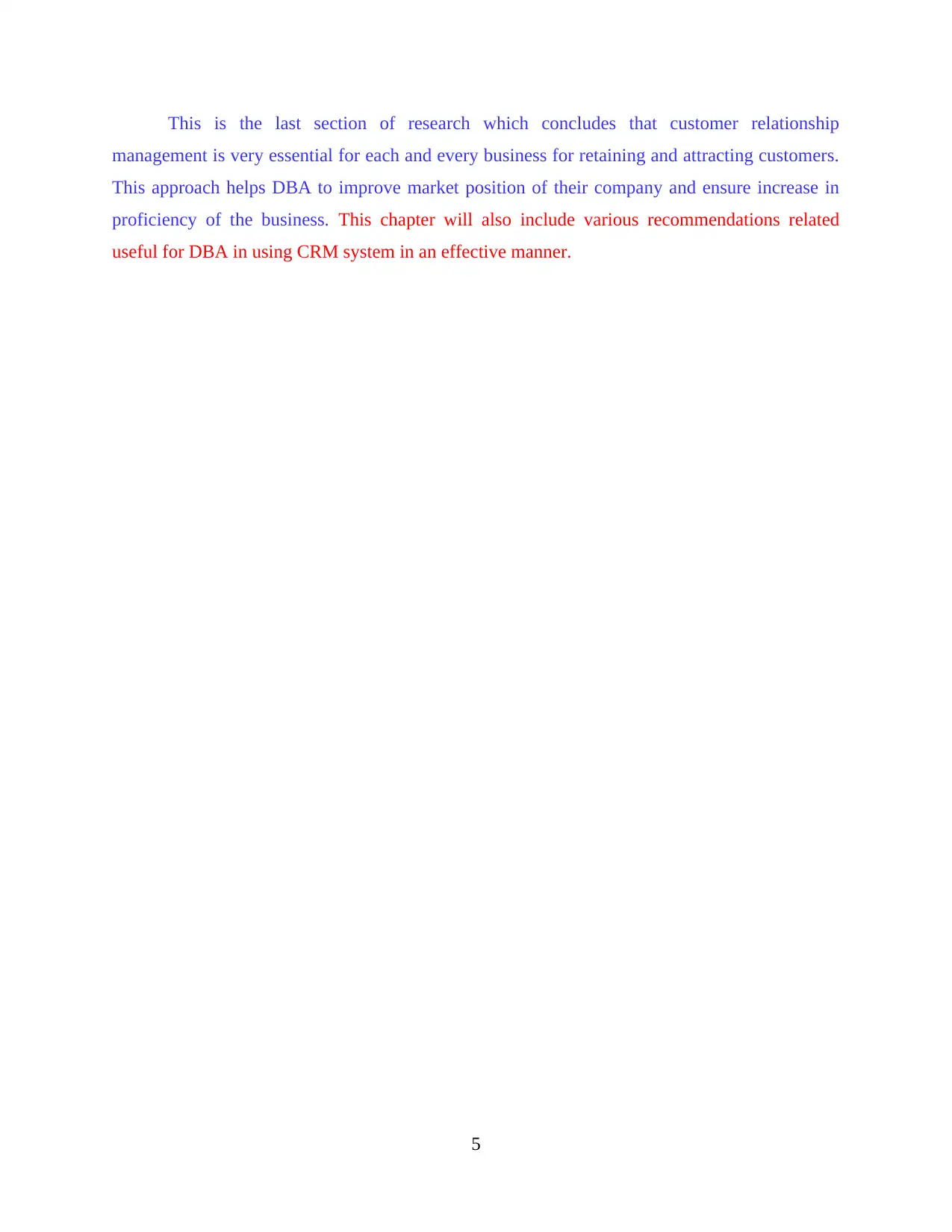
This is the last section of research which concludes that customer relationship
management is very essential for each and every business for retaining and attracting customers.
This approach helps DBA to improve market position of their company and ensure increase in
proficiency of the business. This chapter will also include various recommendations related
useful for DBA in using CRM system in an effective manner.
5
management is very essential for each and every business for retaining and attracting customers.
This approach helps DBA to improve market position of their company and ensure increase in
proficiency of the business. This chapter will also include various recommendations related
useful for DBA in using CRM system in an effective manner.
5
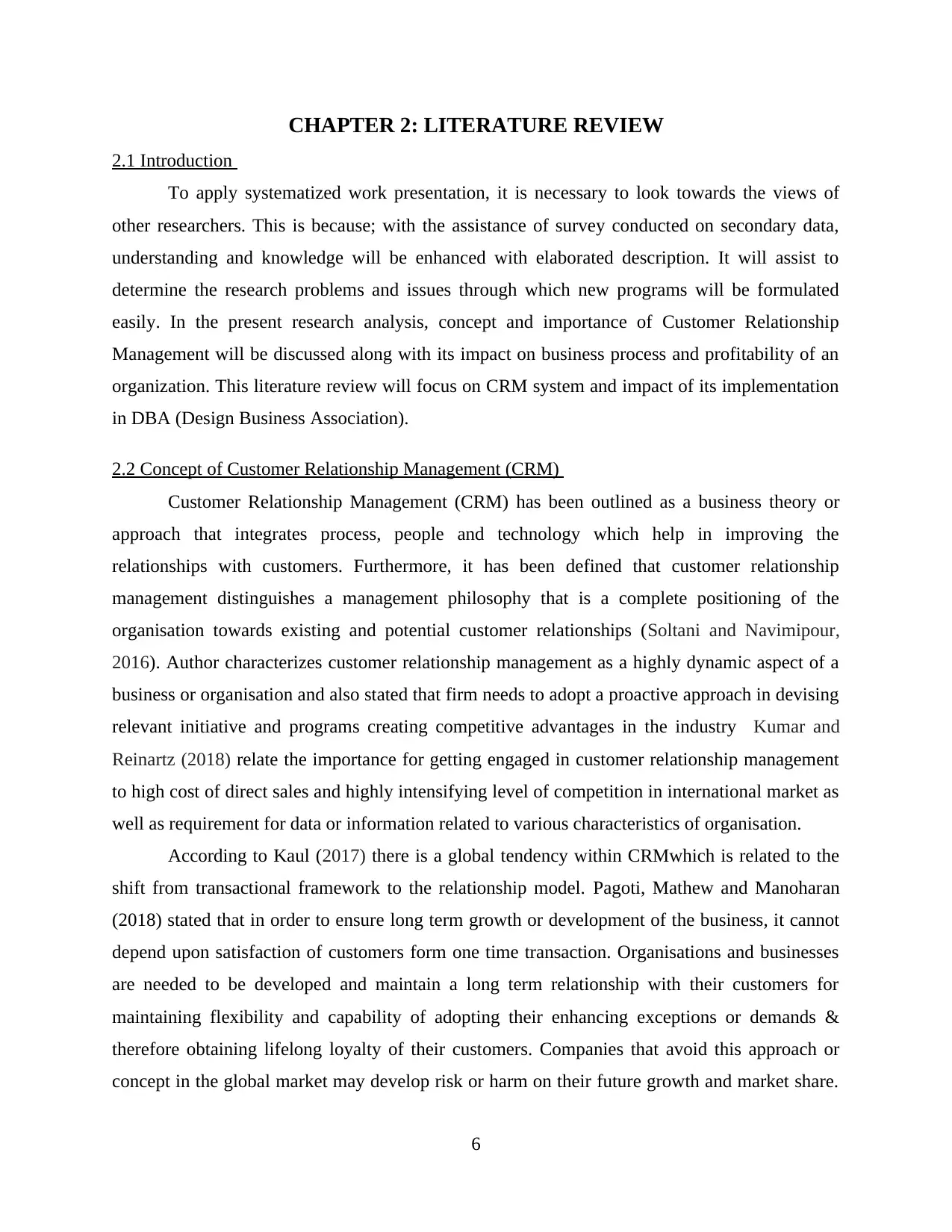
CHAPTER 2: LITERATURE REVIEW
2.1 Introduction
To apply systematized work presentation, it is necessary to look towards the views of
other researchers. This is because; with the assistance of survey conducted on secondary data,
understanding and knowledge will be enhanced with elaborated description. It will assist to
determine the research problems and issues through which new programs will be formulated
easily. In the present research analysis, concept and importance of Customer Relationship
Management will be discussed along with its impact on business process and profitability of an
organization. This literature review will focus on CRM system and impact of its implementation
in DBA (Design Business Association).
2.2 Concept of Customer Relationship Management (CRM)
Customer Relationship Management (CRM) has been outlined as a business theory or
approach that integrates process, people and technology which help in improving the
relationships with customers. Furthermore, it has been defined that customer relationship
management distinguishes a management philosophy that is a complete positioning of the
organisation towards existing and potential customer relationships (Soltani and Navimipour,
2016). Author characterizes customer relationship management as a highly dynamic aspect of a
business or organisation and also stated that firm needs to adopt a proactive approach in devising
relevant initiative and programs creating competitive advantages in the industry Kumar and
Reinartz (2018) relate the importance for getting engaged in customer relationship management
to high cost of direct sales and highly intensifying level of competition in international market as
well as requirement for data or information related to various characteristics of organisation.
According to Kaul (2017) there is a global tendency within CRMwhich is related to the
shift from transactional framework to the relationship model. Pagoti, Mathew and Manoharan
(2018) stated that in order to ensure long term growth or development of the business, it cannot
depend upon satisfaction of customers form one time transaction. Organisations and businesses
are needed to be developed and maintain a long term relationship with their customers for
maintaining flexibility and capability of adopting their enhancing exceptions or demands &
therefore obtaining lifelong loyalty of their customers. Companies that avoid this approach or
concept in the global market may develop risk or harm on their future growth and market share.
6
2.1 Introduction
To apply systematized work presentation, it is necessary to look towards the views of
other researchers. This is because; with the assistance of survey conducted on secondary data,
understanding and knowledge will be enhanced with elaborated description. It will assist to
determine the research problems and issues through which new programs will be formulated
easily. In the present research analysis, concept and importance of Customer Relationship
Management will be discussed along with its impact on business process and profitability of an
organization. This literature review will focus on CRM system and impact of its implementation
in DBA (Design Business Association).
2.2 Concept of Customer Relationship Management (CRM)
Customer Relationship Management (CRM) has been outlined as a business theory or
approach that integrates process, people and technology which help in improving the
relationships with customers. Furthermore, it has been defined that customer relationship
management distinguishes a management philosophy that is a complete positioning of the
organisation towards existing and potential customer relationships (Soltani and Navimipour,
2016). Author characterizes customer relationship management as a highly dynamic aspect of a
business or organisation and also stated that firm needs to adopt a proactive approach in devising
relevant initiative and programs creating competitive advantages in the industry Kumar and
Reinartz (2018) relate the importance for getting engaged in customer relationship management
to high cost of direct sales and highly intensifying level of competition in international market as
well as requirement for data or information related to various characteristics of organisation.
According to Kaul (2017) there is a global tendency within CRMwhich is related to the
shift from transactional framework to the relationship model. Pagoti, Mathew and Manoharan
(2018) stated that in order to ensure long term growth or development of the business, it cannot
depend upon satisfaction of customers form one time transaction. Organisations and businesses
are needed to be developed and maintain a long term relationship with their customers for
maintaining flexibility and capability of adopting their enhancing exceptions or demands &
therefore obtaining lifelong loyalty of their customers. Companies that avoid this approach or
concept in the global market may develop risk or harm on their future growth and market share.
6
⊘ This is a preview!⊘
Do you want full access?
Subscribe today to unlock all pages.

Trusted by 1+ million students worldwide
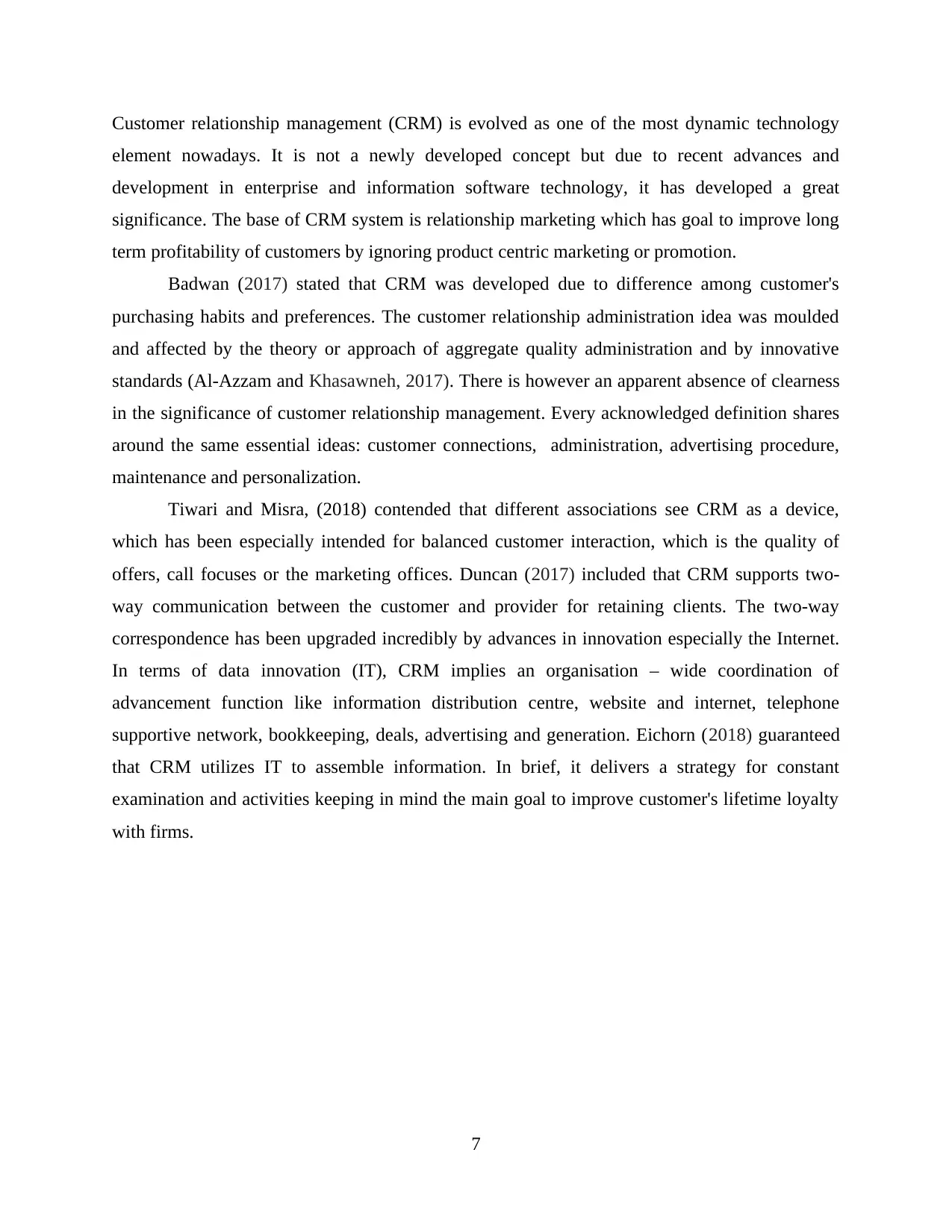
Customer relationship management (CRM) is evolved as one of the most dynamic technology
element nowadays. It is not a newly developed concept but due to recent advances and
development in enterprise and information software technology, it has developed a great
significance. The base of CRM system is relationship marketing which has goal to improve long
term profitability of customers by ignoring product centric marketing or promotion.
Badwan (2017) stated that CRM was developed due to difference among customer's
purchasing habits and preferences. The customer relationship administration idea was moulded
and affected by the theory or approach of aggregate quality administration and by innovative
standards (Al-Azzam and Khasawneh, 2017). There is however an apparent absence of clearness
in the significance of customer relationship management. Every acknowledged definition shares
around the same essential ideas: customer connections, administration, advertising procedure,
maintenance and personalization.
Tiwari and Misra, (2018) contended that different associations see CRM as a device,
which has been especially intended for balanced customer interaction, which is the quality of
offers, call focuses or the marketing offices. Duncan (2017) included that CRM supports two-
way communication between the customer and provider for retaining clients. The two-way
correspondence has been upgraded incredibly by advances in innovation especially the Internet.
In terms of data innovation (IT), CRM implies an organisation – wide coordination of
advancement function like information distribution centre, website and internet, telephone
supportive network, bookkeeping, deals, advertising and generation. Eichorn (2018) guaranteed
that CRM utilizes IT to assemble information. In brief, it delivers a strategy for constant
examination and activities keeping in mind the main goal to improve customer's lifetime loyalty
with firms.
7
element nowadays. It is not a newly developed concept but due to recent advances and
development in enterprise and information software technology, it has developed a great
significance. The base of CRM system is relationship marketing which has goal to improve long
term profitability of customers by ignoring product centric marketing or promotion.
Badwan (2017) stated that CRM was developed due to difference among customer's
purchasing habits and preferences. The customer relationship administration idea was moulded
and affected by the theory or approach of aggregate quality administration and by innovative
standards (Al-Azzam and Khasawneh, 2017). There is however an apparent absence of clearness
in the significance of customer relationship management. Every acknowledged definition shares
around the same essential ideas: customer connections, administration, advertising procedure,
maintenance and personalization.
Tiwari and Misra, (2018) contended that different associations see CRM as a device,
which has been especially intended for balanced customer interaction, which is the quality of
offers, call focuses or the marketing offices. Duncan (2017) included that CRM supports two-
way communication between the customer and provider for retaining clients. The two-way
correspondence has been upgraded incredibly by advances in innovation especially the Internet.
In terms of data innovation (IT), CRM implies an organisation – wide coordination of
advancement function like information distribution centre, website and internet, telephone
supportive network, bookkeeping, deals, advertising and generation. Eichorn (2018) guaranteed
that CRM utilizes IT to assemble information. In brief, it delivers a strategy for constant
examination and activities keeping in mind the main goal to improve customer's lifetime loyalty
with firms.
7
Paraphrase This Document
Need a fresh take? Get an instant paraphrase of this document with our AI Paraphraser
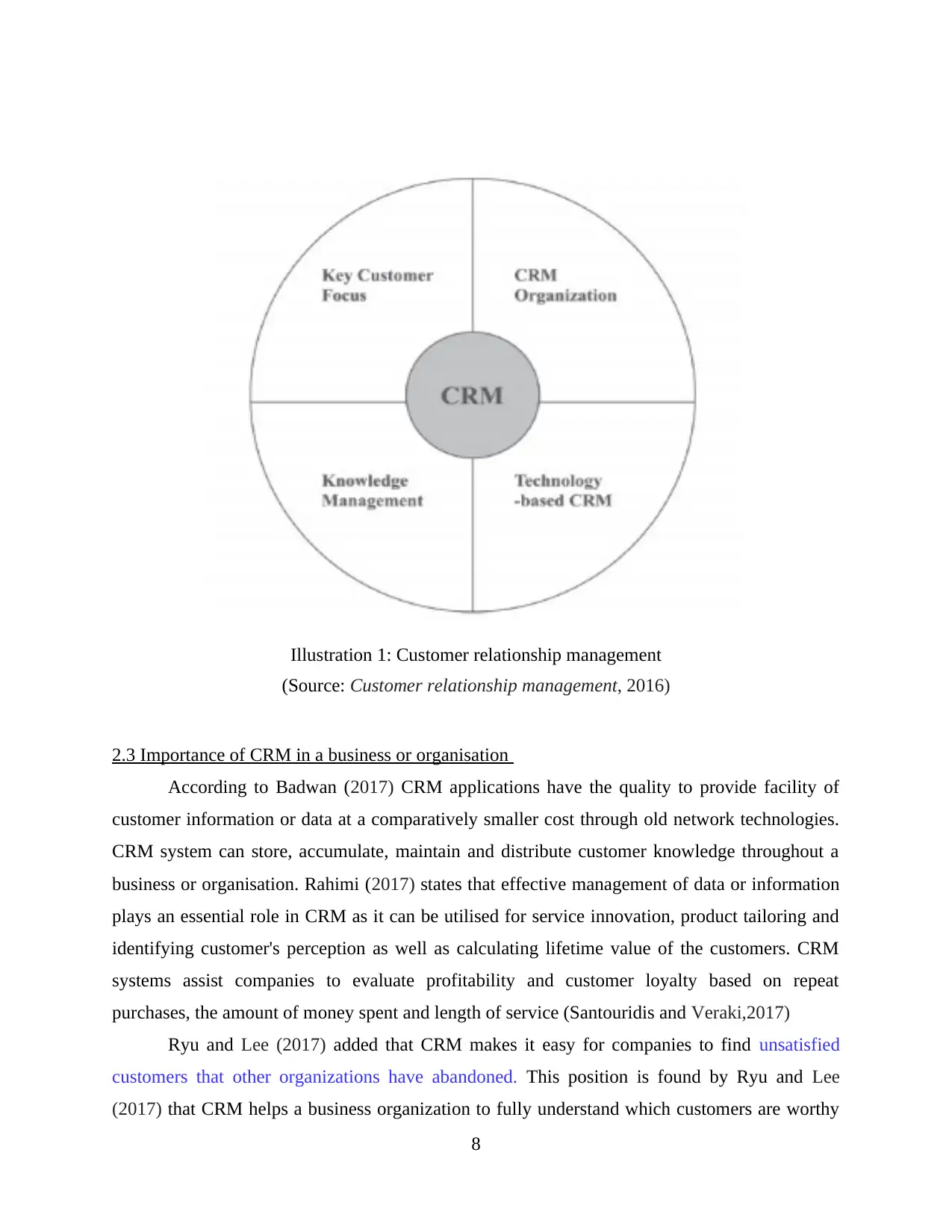
2.3 Importance of CRM in a business or organisation
According to Badwan (2017) CRM applications have the quality to provide facility of
customer information or data at a comparatively smaller cost through old network technologies.
CRM system can store, accumulate, maintain and distribute customer knowledge throughout a
business or organisation. Rahimi (2017) states that effective management of data or information
plays an essential role in CRM as it can be utilised for service innovation, product tailoring and
identifying customer's perception as well as calculating lifetime value of the customers. CRM
systems assist companies to evaluate profitability and customer loyalty based on repeat
purchases, the amount of money spent and length of service (Santouridis and Veraki,2017)
Ryu and Lee (2017) added that CRM makes it easy for companies to find unsatisfied
customers that other organizations have abandoned. This position is found by Ryu and Lee
(2017) that CRM helps a business organization to fully understand which customers are worthy
8
Illustration 1: Customer relationship management
(Source: Customer relationship management, 2016)
According to Badwan (2017) CRM applications have the quality to provide facility of
customer information or data at a comparatively smaller cost through old network technologies.
CRM system can store, accumulate, maintain and distribute customer knowledge throughout a
business or organisation. Rahimi (2017) states that effective management of data or information
plays an essential role in CRM as it can be utilised for service innovation, product tailoring and
identifying customer's perception as well as calculating lifetime value of the customers. CRM
systems assist companies to evaluate profitability and customer loyalty based on repeat
purchases, the amount of money spent and length of service (Santouridis and Veraki,2017)
Ryu and Lee (2017) added that CRM makes it easy for companies to find unsatisfied
customers that other organizations have abandoned. This position is found by Ryu and Lee
(2017) that CRM helps a business organization to fully understand which customers are worthy
8
Illustration 1: Customer relationship management
(Source: Customer relationship management, 2016)
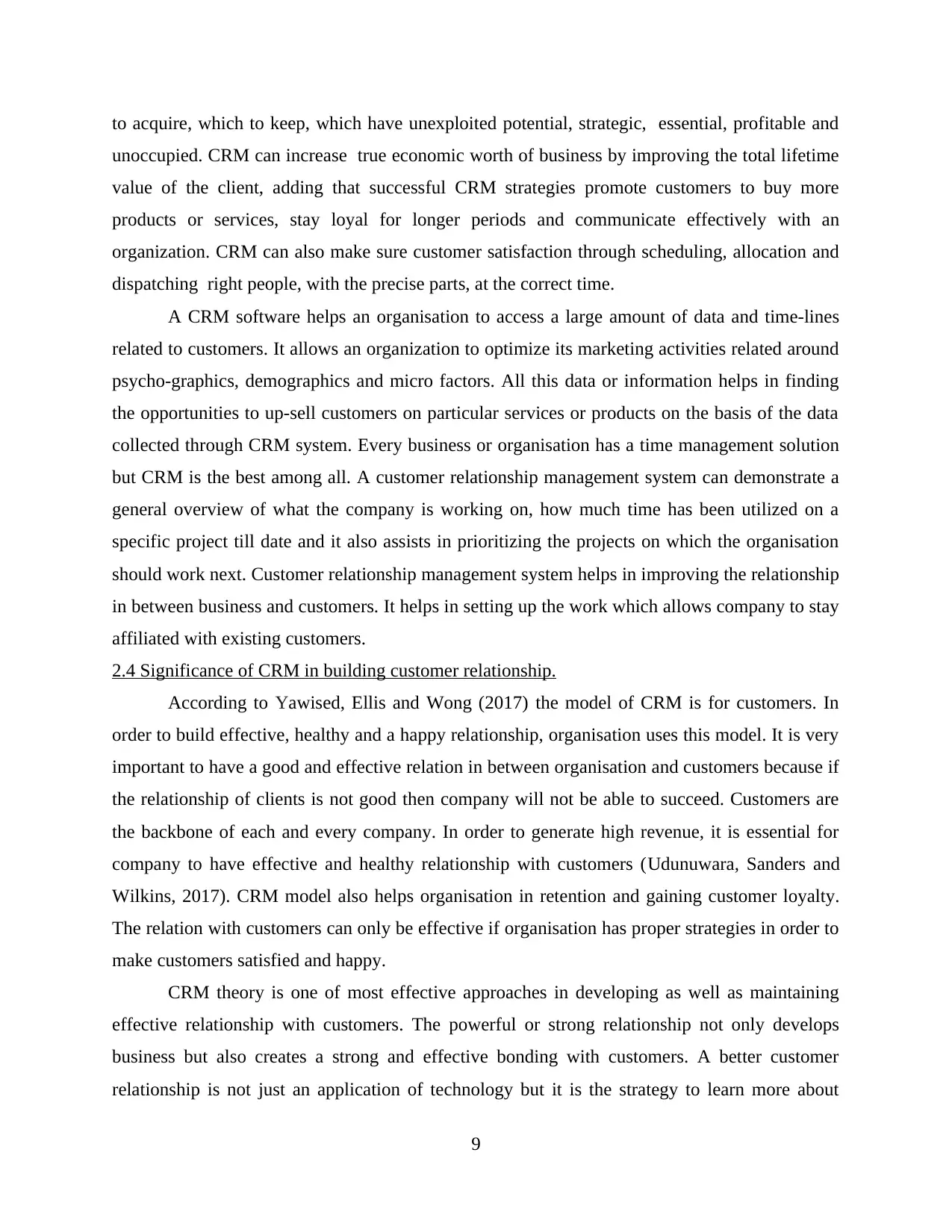
to acquire, which to keep, which have unexploited potential, strategic, essential, profitable and
unoccupied. CRM can increase true economic worth of business by improving the total lifetime
value of the client, adding that successful CRM strategies promote customers to buy more
products or services, stay loyal for longer periods and communicate effectively with an
organization. CRM can also make sure customer satisfaction through scheduling, allocation and
dispatching right people, with the precise parts, at the correct time.
A CRM software helps an organisation to access a large amount of data and time-lines
related to customers. It allows an organization to optimize its marketing activities related around
psycho-graphics, demographics and micro factors. All this data or information helps in finding
the opportunities to up-sell customers on particular services or products on the basis of the data
collected through CRM system. Every business or organisation has a time management solution
but CRM is the best among all. A customer relationship management system can demonstrate a
general overview of what the company is working on, how much time has been utilized on a
specific project till date and it also assists in prioritizing the projects on which the organisation
should work next. Customer relationship management system helps in improving the relationship
in between business and customers. It helps in setting up the work which allows company to stay
affiliated with existing customers.
2.4 Significance of CRM in building customer relationship.
According to Yawised, Ellis and Wong (2017) the model of CRM is for customers. In
order to build effective, healthy and a happy relationship, organisation uses this model. It is very
important to have a good and effective relation in between organisation and customers because if
the relationship of clients is not good then company will not be able to succeed. Customers are
the backbone of each and every company. In order to generate high revenue, it is essential for
company to have effective and healthy relationship with customers (Udunuwara, Sanders and
Wilkins, 2017). CRM model also helps organisation in retention and gaining customer loyalty.
The relation with customers can only be effective if organisation has proper strategies in order to
make customers satisfied and happy.
CRM theory is one of most effective approaches in developing as well as maintaining
effective relationship with customers. The powerful or strong relationship not only develops
business but also creates a strong and effective bonding with customers. A better customer
relationship is not just an application of technology but it is the strategy to learn more about
9
unoccupied. CRM can increase true economic worth of business by improving the total lifetime
value of the client, adding that successful CRM strategies promote customers to buy more
products or services, stay loyal for longer periods and communicate effectively with an
organization. CRM can also make sure customer satisfaction through scheduling, allocation and
dispatching right people, with the precise parts, at the correct time.
A CRM software helps an organisation to access a large amount of data and time-lines
related to customers. It allows an organization to optimize its marketing activities related around
psycho-graphics, demographics and micro factors. All this data or information helps in finding
the opportunities to up-sell customers on particular services or products on the basis of the data
collected through CRM system. Every business or organisation has a time management solution
but CRM is the best among all. A customer relationship management system can demonstrate a
general overview of what the company is working on, how much time has been utilized on a
specific project till date and it also assists in prioritizing the projects on which the organisation
should work next. Customer relationship management system helps in improving the relationship
in between business and customers. It helps in setting up the work which allows company to stay
affiliated with existing customers.
2.4 Significance of CRM in building customer relationship.
According to Yawised, Ellis and Wong (2017) the model of CRM is for customers. In
order to build effective, healthy and a happy relationship, organisation uses this model. It is very
important to have a good and effective relation in between organisation and customers because if
the relationship of clients is not good then company will not be able to succeed. Customers are
the backbone of each and every company. In order to generate high revenue, it is essential for
company to have effective and healthy relationship with customers (Udunuwara, Sanders and
Wilkins, 2017). CRM model also helps organisation in retention and gaining customer loyalty.
The relation with customers can only be effective if organisation has proper strategies in order to
make customers satisfied and happy.
CRM theory is one of most effective approaches in developing as well as maintaining
effective relationship with customers. The powerful or strong relationship not only develops
business but also creates a strong and effective bonding with customers. A better customer
relationship is not just an application of technology but it is the strategy to learn more about
9
⊘ This is a preview!⊘
Do you want full access?
Subscribe today to unlock all pages.

Trusted by 1+ million students worldwide
1 out of 43
Related Documents
Your All-in-One AI-Powered Toolkit for Academic Success.
+13062052269
info@desklib.com
Available 24*7 on WhatsApp / Email
![[object Object]](/_next/static/media/star-bottom.7253800d.svg)
Unlock your academic potential
Copyright © 2020–2025 A2Z Services. All Rights Reserved. Developed and managed by ZUCOL.





